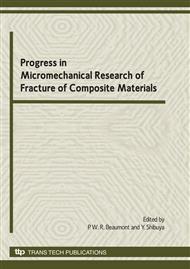p.19
p.31
p.41
p.47
p.53
p.69
p.83
p.101
p.115
Effect of Matrix Hardening on Tensile Strength of Alumina-Fiber Reinforced Aluminum Matrix Composites
Abstract:
This paper examines the stress distribution around a fiber break in alumina-fiber reinforced aluminum matrix (Al2O3/Al) composites using finite element analysis and predicts the tensile strength using tensile failure simulations. In particular, we discuss the effect of the matrix hardening on the tensile failure of the Al2O3/Al composites. First, we clarify the differences in the stress distribution around a fiber break between an elastic-perfect plastic matrix and an elastic-plastic hardening matrix using finite element analysis. Second, the procedure for simulating fiber damage evolution in the Al2O3/Al composites is presented. The simulation incorporates the analytical solution for the axial fiber stress distribution of a broken fiber in the spring element model for the stress analysis of the whole composite. Finally, we conduct Monte Carlo simulations of fiber damage evolution to predict the tensile strength of the Al2O3/Al composites, and discuss the effect of matrix hardening on the tensile strength of the Al2O3/Al composites. Coupled with size-scaling analysis, the simulated results express the size effect on the strength of the composites, which is seen in experimental results.
Info:
Periodical:
Pages:
83-99
Citation:
Online since:
March 2010
Authors:
Price:
Сopyright:
© 2010 Trans Tech Publications Ltd. All Rights Reserved
Share:
Citation:


